DARYOOSH SAEEDKIA, TETECHS INC.
Conducting accurate thickness measurements is essential for ensuring consistent quality of products such as plastic bottles and containers; however, measurement techniques are often invasive, destructive, time-consuming and wasteful.
Unlike traditional methods, terahertz (THz) technology offers a nondestructive solution when it comes to thickness measurement. Terahertz photoconductive antennas (THz-PCAs) allow for quick, noncontact thickness measurements of both opaque and translucent materials such as plastics, coatings, rubbers and glass. Furthermore, generating and detecting THz signals using THz-PCAs is perfectly suited for highly accurate measurements of both monolayer and multilayer structures with layers thinner than a strand of hair.
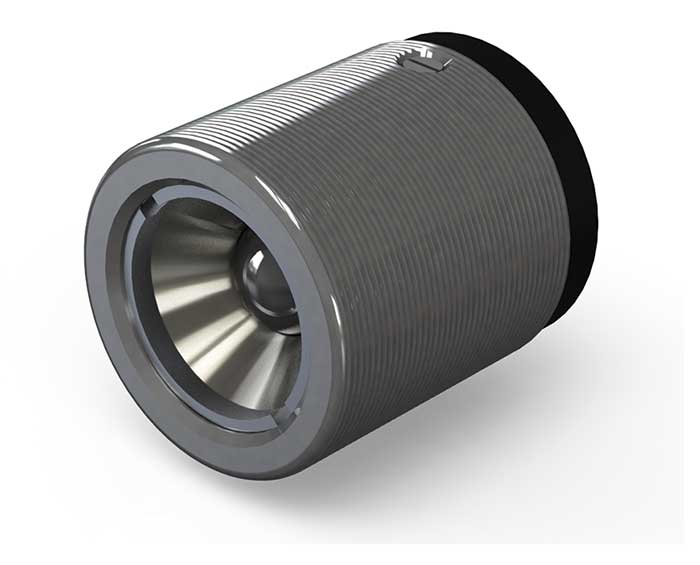
A terahertz air photoconductive antenna (THz-PCA) such as this one achieves relatively high signal-to-noise ratios. Courtesy of TeTechS.
With the recent advances in this technology, THz-powered solutions are making their way from research labs to factory floors as the new solution to long-time measurement challenges.
Tradition versus terahertz
For many years, the real-world applications for THz technology were unknown. The elusive properties of these waves have long posed challenges to researchers who worked to find an affordable way to generate THz that are bright enough for day-to-day use. Today, THz technology is ever-evolving and is making its mark across research labs and industries alike.
Closing the “gap” along the electromagnetic spectrum, THz lies between microwave and infrared in the range from 1 mm to 100 µm (300 GHz to 3 THz) and has a wavelength of 3 mm to 30 µm.
The unique characteristics of terahertz waves make them a viable solution for challenges facing markets ranging from security to manufacturing. Because of its ability to see through common materials that other technologies cannot, THz can be applied to areas such as plastic bottle manufacturing, plastic recycling, material identification and void detection.
THz-PCAs are among the most promising devices that are used to harness the properties of THz waves for a variety of applications including thickness measurement of plastics.
Using THz-PCAs for the generation and detection of THz signals achieves relatively high signal-to-noise ratios and enables fast scan for imaging and spectroscopy applications. Widely used in THz time-domain spectroscopy systems, broadband THz pulses can be generated by exciting THz-PCAs with a femtosecond short pulse laser to generate and detect THz pulses with a bandwidth of up to 4 THz.
Since their demonstration as practical THz sources and detectors, THz-PCAs have been the subject of a vast number of scientific and industrial reports investigating their application in a “real” world environment.
Terahertz waves and thickness measurement
A reflection-mode, time-domain THz pulse measurement setup can effectively perform thickness measurement of plastic preforms, bottles, containers and
thin-wall packaging.
THz pulses from the transmitter go to the sample under test, and the reflected pulses are coupled into the detector. The THz pulse reflects from the sample’s walls and/or layers and generates a specific time delay that allows for the calculation of the thickness of each wall/layer in a noncontact, nondestructive way. The peak amplitudes of the reflected pulses also decrease as they experience absorption loss and Fresnel reflections.
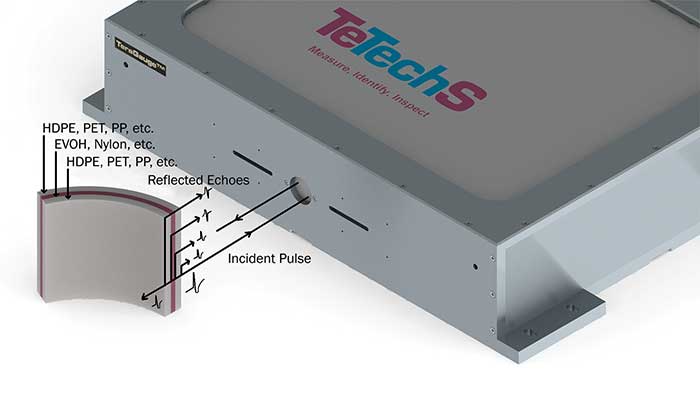
TeTechS’ TeraGauge uses the terahertz time-domain principle. Courtesy of TeTechS.
By employing the THz time-domain principle, this technique can be used for any monolayer or multilayer plastic structure. It can provide quick and precise measurements of both opaque and translucent plastics as well as for any ultra-thin barrier layer that may lie within a structure. Unlike traditional methods, the use of THz-PCAs to conduct reliable and repeatable thickness measurement is fast, flexible and minimizes waste (see sidebar at the end of this article).
The new technique in town
Because of the difficulty of making industrial-grade and cost-effective sources and detectors for this range of the frequency, THz has only recently emerged as a solution amongst major players such as x-ray and infrared. TeTechS, based in Waterloo, Ontario, Canada, has launched one such solution, a thickness-testing gauge powered by THz waves called TeraGauge.
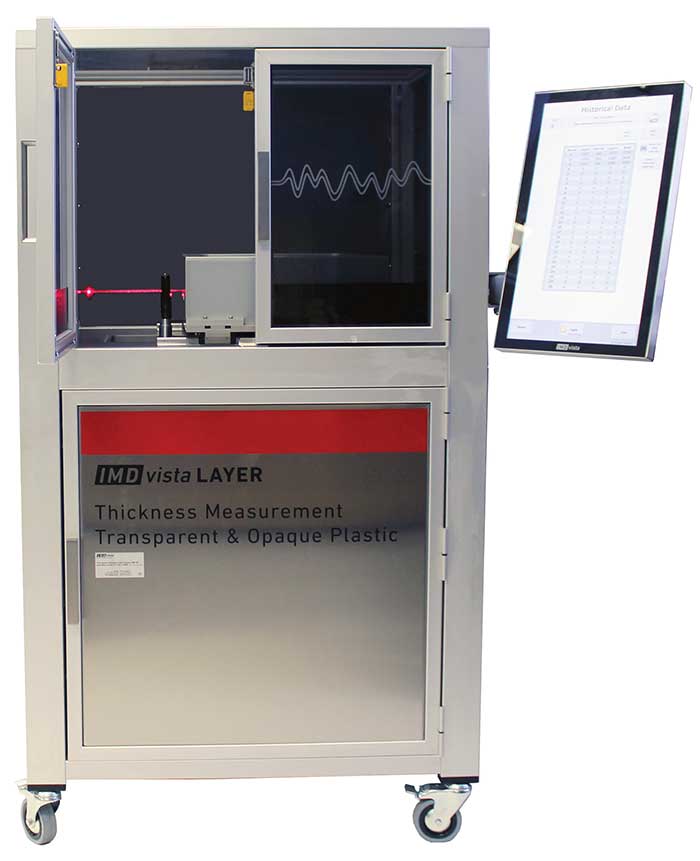
IMDvista LAYER is designed specifically for plastic preforms, bottles, containers and thin-wall packaging. Courtesy of TeTechS.
At its core, TeraGauge houses two THz-PCAs that allow the gauge to conduct quick and precise time-delay measurements of the sample under test.
While TeraGauge is currently integrated as a thickness measurement solution for plastics, the applications for such technology also can be extended to hose and tubes as well as coatings and paints.
Compared to traditional measurement techniques, THz-PCAs are seeing a real-world use with technology such as TeTechS’ TeraGauge that is providing a solution to a long-time manufacturing challenge. This emergence of a robust high-quality version of a once challenging technology ultimately can save manufacturers time, money and materials.
The gauge is at the heart of IMDvista LAYER, a thickness measurement
system designed specifically for plastic and thin-wall packaging.
Essentially, this system enables users to forgo traditional measurement
techniques and conduct measurements of up to 10 layers ranging in
thickness from 0.01 mm to 5 mm in a matter of seconds, while also
locating and measuring the barrier layer within the structure.
Meet the author
Dr. Daryoosh Saeedkia is the founder and CEO of TeTechS, a provider of advanced measurement solutions that are powered by terahertz technology; email: [email protected].
The Plastics Conundrum
Despite a vast use case, traditional thickness measurement techniques for plastic packaging are limited and subject to major pitfalls.
One example is use of Hall effect (Magna-Mike) measurement probes. This method runs a magnetic probe along the exterior of the sample under test, while a small metal target ball is placed on the inside. The probe’s Hall effect sensor then measures the distance between the probe tip and the target ball to provide the wall thickness of the sample. Although nondestructive, this technique is time-consuming and limited to overall wall thickness, making it inefficient for use on multi-layer samples wherein the barrier layer plays a key role.
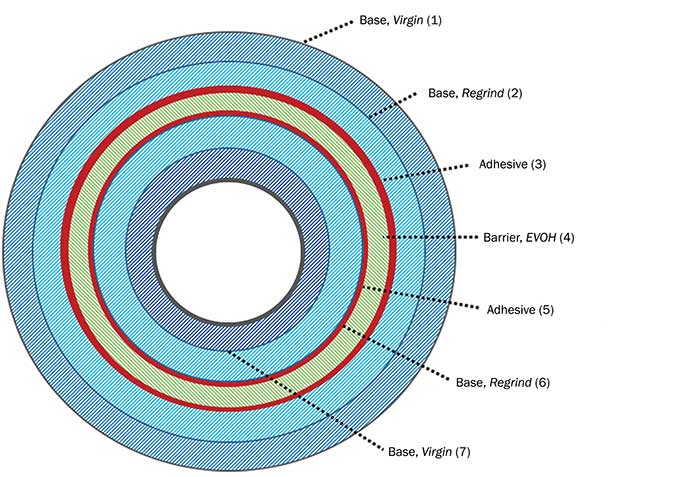
Among the components of a multilayer plastic structure is an ultra-thin barrier layer essential to quality control. Courtesy of TeTechS.
Multilayer plastic bottles and containers are in wide use and characterized by an ultra-thin barrier layer composed of materials such as EVOH or PET. The barrier layer is the thinnest within the structure, while also boasting the highest price tag. Ensuring that the barrier layer is present and consistent throughout the structure is essential for quality control. Even the smallest imperfection in it can jeopardize the integrity of the product and ultimately cost both time and money.
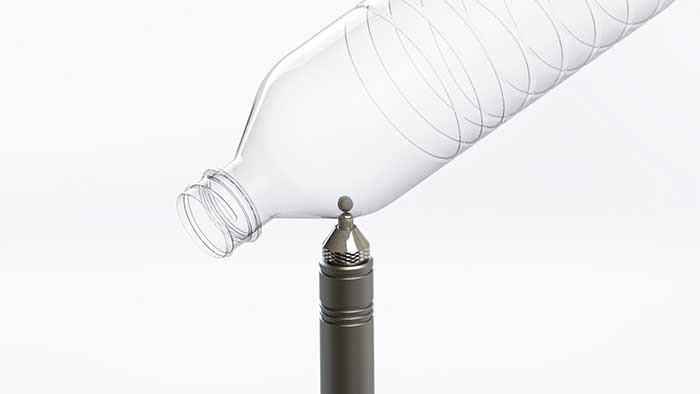
A Magna-Mike probe can be used only to measure overall wall thickness. Courtesy of TeTechS.
Another measurement technology, infrared interferometry, also cannot be used with multilayer samples, and it is incapable of measuring opaque materials.
To check and measure thickness for multilayer packaging, manufacturers turned to destructive testing techniques. Time-consuming, wasteful and high in labor costs, these tests require that multilayer packaging be physically cut and each layer peeled and measured.
These traditional techniques have long served as the only solution to thickness measurement challenges, but they come with an extremely high price tag to manufacturers, their employees and the environment.